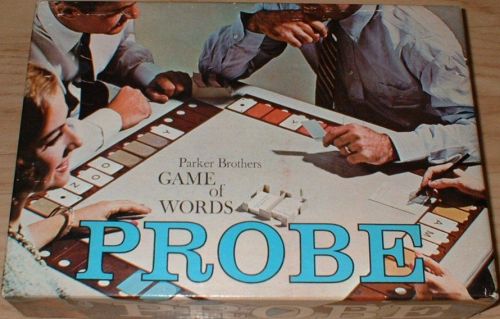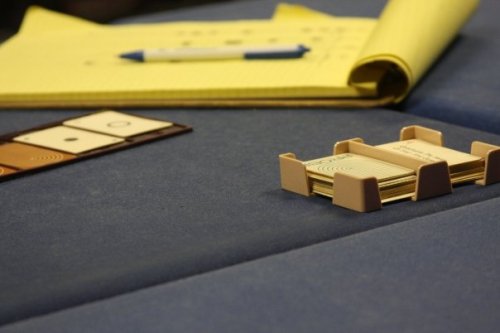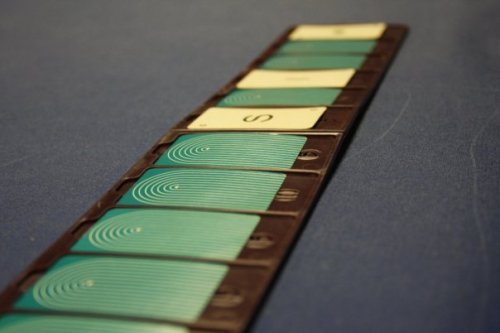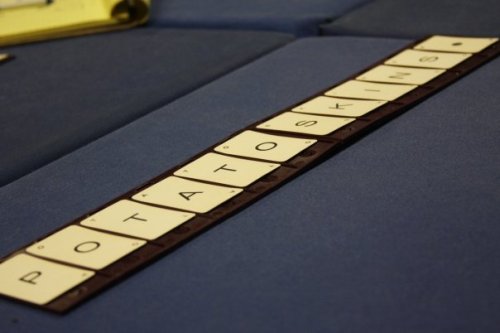Probe: I’m trying very hard not to use double entendre in this review.

[An admirable review from a few years ago, but, honestly, it could have used a bit more humor. I’m just saying.
Oh, yes, and I forgot! Junelle Faye took all the pictures in this review, as well as the ones in ‘Tales of the Arabian Nights’ and ‘The Adventurers’. She’s also the kind of stinker who thinks that “PotatoSkins” is a real word. You can check out more of Junelle’s photos and artwork at junabelle.deviantart.com]
This review was originally posted at Guilt-Free-Games.com.
Why should we review a game that’s over 40 years old? Probe was first printed in 1964, and remade in the mid-70s, but hasn’t seen print for over 30 years. The game looks like a relic lost to simpler times before 100-sided dice, endless piles of counters and the Pop-O-Matic. If Parker Brothers continued to publish games like ‘Life’ and ‘Mall Madness’, why did they shelf this game?
 For one thing, despite the game’s gentrification, Probe isn’t that hard to get your hands on. If your local game store doesn’t stock classic games, it’s easy to find a copy on eBay. A quick scan tells me that Probe sells for about six to ten dollars. I happened upon my copy at a yard sale marked for 25 cents.
For one thing, despite the game’s gentrification, Probe isn’t that hard to get your hands on. If your local game store doesn’t stock classic games, it’s easy to find a copy on eBay. A quick scan tells me that Probe sells for about six to ten dollars. I happened upon my copy at a yard sale marked for 25 cents.
So why has a game like Probe not been printed since the 1970s? I blame Toy ‘R Us. During the 1980s Toys ‘R Us had become the place for companies like Milton Bradley and Parker Brothers to sell a vast share of their inventory. In this new market it was common parlance that games were bought either for children, or to be played with children. This mentality would change when Trivial Pursuit rose from being an independent game produced at great expense by a couple of Canadian amateurs to one of the bestselling games of all time. Trivial Pursuit smashed game publishers’ expectations by showing that games geared toward adults rewarding intelligence could not only be profitable, but were highly desirable. Since this ‘new’ market consisted of twenty and thirty-somethings, Milton Bradley crusaded their way into a host of trendy new adult games like Pictionary and Taboo, but made little attempt to resurrect its older adult game line.

In Probe, each player takes a rack with ten blank spaces on it, and a pile of cards with individual letters on them. They then build a word, placing the letter cards face down on their rack, filling any blank spaces with a blank card. On each player’s turn, that player flips over a ‘chance’ card that will say something like “If you have a blank, expose it” or “Opponent on your left will reveal a card”. You then guess a letter an opponent has on his rack; If he has that letter in his word he reveals one copy of that letter on his rack. At any point in the game, any player can stop the game and guess what word a person has.
There are a lot of points thrown around in this game for different reasons. Whenever you correctly guess a letter, you gain points depending on where it is located on the rack. Some of the chance cards increase the point value of a guess, or just give you random points. The big whopper, though, is guessing a person’s word… but you want to be careful with this one. If you are wrong, you instead lose that pile of points.
There’s a little strategy, too. Which ‘T’ in your word should you show an opponent? Should you reveal your last blank and let an opponent have 15 points, or a crucial ‘E’ that will only give a player 5 points? Also, even if your word has been guessed, you’re still playing the game, wracking up points and trying to guess your opponents words. All the players are invested in the game, but the feel is casual, not intense.

At first glance, Probe is little more than the game of Hangman repackaged to not look like Hangman. While it has obvious Hangman roots, it employs enough tricks to make it enjoyable on its own merits. It also elevates a game you play with children while you’re waiting for food at a diner into a sociable game to play with another couple over coffee and cookies. I’ve shown it to more than a couple of skeptical play groups who begin by mocking the game and end by praising it. It’s a fun game, even if it wouldn’t have sold many copies in Toys ‘R Us during the 1980s.


















